Er den danske konge, der gav navn til Bluetooth, begravet i Polen?
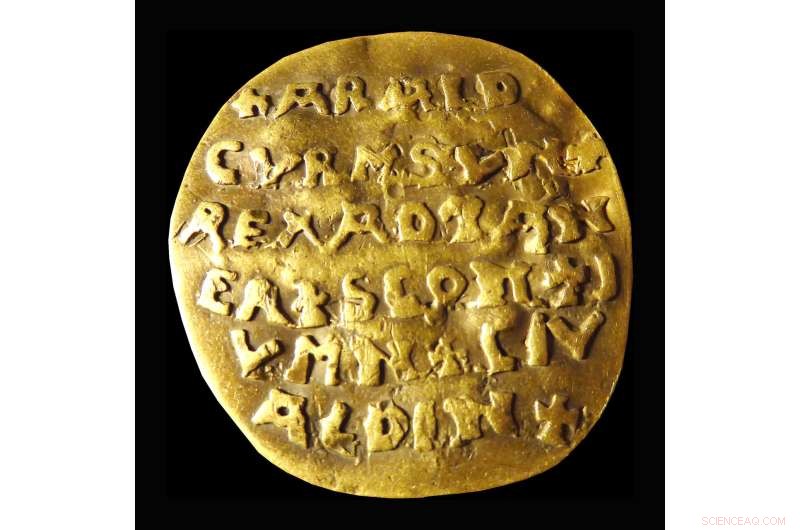
Den gyldne Curmsun-skive fra det 10. århundrede med navnet på den danske kong Harald "Bluetooth" Gormsson (Curmsun på latin), der kommer fra en grav ved den romersk-katolske kirke i Wiejkowo, Polen, fotograferet i Malmø, Sverige, i 2015. Bluetooth trådløs forbindelsesteknologi er opkaldt efter kongen. Mere end 1.000 år efter hans død i det nuværende Polen er en dansk konge, hvis kælenavn er kendt af verden gennem Bluetooth-teknologien, i centrum for en arkæologisk strid. Kredit:Sven Rosborn via AP
Mere end 1.000 år efter hans død i det nuværende Polen, er en europæisk konge, hvis kælenavn lever videre gennem trådløs teknologi, i centrum af en arkæologisk strid.
Kronikker fra middelalderen siger, at kong Harald "Bluetooth" Gormsson af Danmark fik sit øgenavn takket være en tand, sandsynligvis død, der så blålig ud. En kronik fra dengang siger også, at vikingekongen blev begravet i Roskilde i slutningen af det 10. århundrede.
Men en svensk arkæolog og en polsk forsker hævdede for nylig i separate publikationer, at de har udpeget hans mest sandsynlige gravsted i landsbyen Wiejkowo, i et område i det nordvestlige Polen, der havde bånd til vikingerne på Haralds tid.
Marek Kryda, forfatter til bogen "Viking Poland," fortalte The Associated Press, at en "hedensk høj", som han hævder, at han har lokaliseret under Wiejkowos romersk-katolske kirke fra det 19. århundrede sandsynligvis rummer kongens rester. Kryda sagde, at geologiske satellitbilleder, der var tilgængelige på en polsk regeringsportal, afslørede en rund form, der lignede en vikingegravhøj.
Men den svenske arkæolog Sven Rosborn siger, at Kryda tager fejl, fordi Harald, der konverterede fra hedenskab til kristendommen og grundlagde kirker i området, skal have fået en passende grav et sted på kirkegården. Wiejkowo's Church of The Immaculate Conception of the Blessed Virgin Mary står på toppen af en lille rund knold.
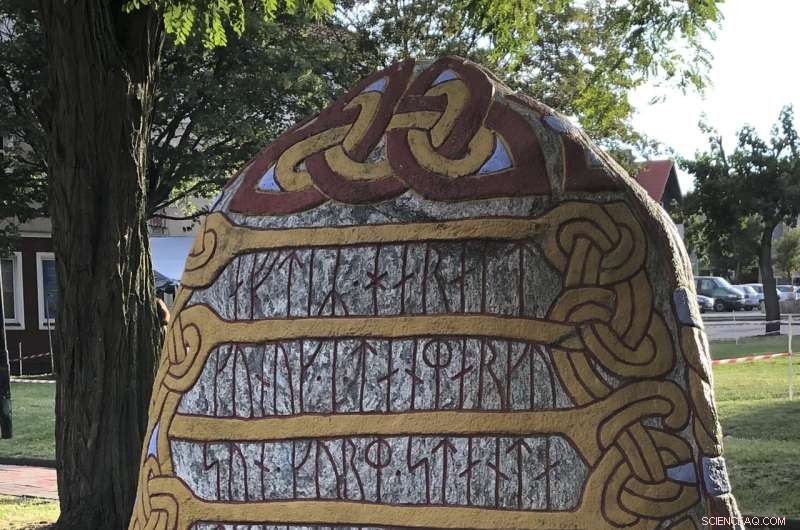
En visning af en sten fra 2014 med runeindskrift til minde om den danske kong Harald "Bluetooth" Gormsson fra det 10. århundrede, i Wolin, Polen, lørdag den 30. juli 2022. Mere end 1.000 år efter hans død i det nuværende Polen er en dansk konge, hvis kælenavn er kendt af verden gennem Bluetooth-teknologien, i centrum for en arkæologisk strid. En polsk forsker og en svensk arkæolog hævder, at de har udpeget det sandsynlige gravsted for kong Harald Blåtand Gormsson i en lille landsby i det nordvestlige Polen, et område, der engang havde bånd til vikingerne. Kredit:AP Photo Monika Scislowska
Historikere på Nationalmuseet i København siger, at de er bekendt med "antydningen" om, at Wiejkowo er Haralds gravsted.
Rosborn detaljerede sin forskning i bogen "Vikingekongens gyldne skat" fra 2021, og Kryda udfordrede nogle af svenskerens resultater i sin egen bog udgivet i år.
Harald, who died in 985, probably in Jomsborg—which is believed to be the Polish town of Wolin now—was one of the last Viking kings to rule over what is now Denmark, northern Germany, and parts of Sweden and Norway. He spread Christianity in his kingdom.
Swedish telecommunications company Ericsson named its Bluetooth wireless link technology after the king, reflecting how he united much of Scandinavia during his lifetime. The logo for the technology is designed from the Scandinavian runic letters for the king's initials, HB.
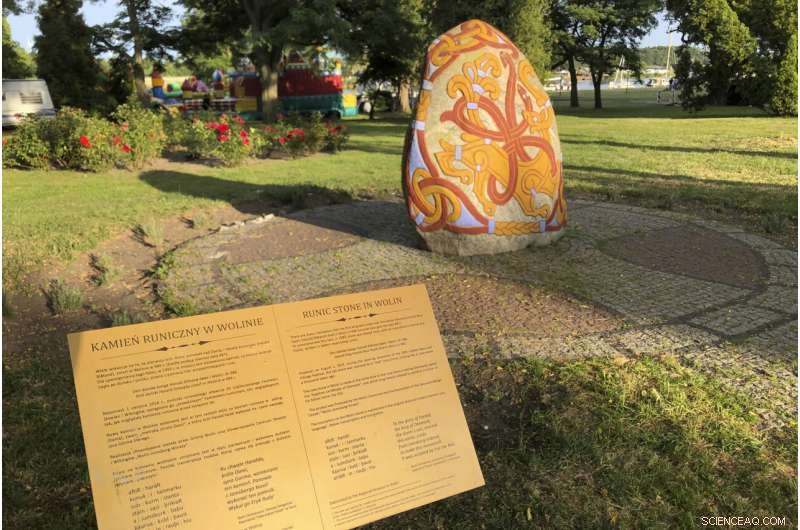
A view of a 2014 stone with runic inscription in memory of Danish 10th century King Harald “Bluetooth” Gormsson, in Wolin, Poland, Saturday, July 30,2022. More than 1,000 years after his death in what is now Poland, a Danish king whose nickname is known to the world through the Bluetooth technology is at the center of an archeological dispute. A Polish researcher and a Swedish archeologist claim that they have pinpointed the probable burial site for King Harald Bluetooth Gormsson in a small village in northwestern Poland, an area that once had ties with the Vikings. Credit:AP Photo Monika Scislowska
Rosborn, the former director of Sweden's Malmo City Museum, was spurred on his quest in 2014 when an 11-year-old girl sought his opinion about a small, soiled coin-like object with old-looking text that had been in her family's possession for decades.
Experts have determined that the cast gold disk that sparked Maja Sielski's curiosity dated from the 10th century. The Latin inscription on what is now known as the "Curmsun disk" says:"Harald Gormsson (Curmsun in Latin) king of Danes, Scania, Jomsborg, town Aldinburg."
Sielski's family, who moved to Sweden from Poland in 1986, said the disk came from a trove found in 1841 in a tomb underneath the Wiejkowo church, which replaced a medieval chapel.
The Sielski family came into the possession of the disk, along with the Wiejkowo parish archives that contained medieval parchment chronicles in Latin, in 1945 as the former German area was becoming part of Poland as a result of World War II.
-

The Roman Catholic church where it is believed that Danish King Harald Gormsson was buried, in Wiejkowo, Poland, Saturday, July 30, 2022. More than 1,000 years after his death in what is now Poland, a Danish king whose nickname is known to the world through the Bluetooth technology is at the center of an archeological dispute. A Polish researcher and a Swedish archeologist claim that they have pinpointed the probable burial site for King Harald Bluetooth Gormsson in a small village in northwestern Poland, an area that once had ties with the Vikings. Credit:AP Photo Monika Scislowska
-
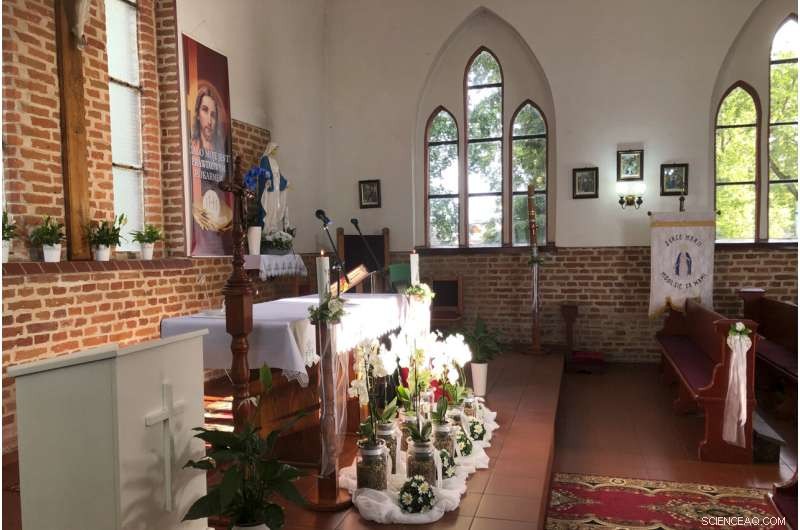
A view inside the Roman Catholic church where it is believed that Danish King Harald Gormsson was buried, in Wiejkowo, Poland, Saturday, July 30, 2022. More than 1,000 years after his death in what is now Poland, a Danish king whose nickname is known to the world through the Bluetooth technology is at the center of an archeological dispute. A Polish researcher and a Swedish archeologist claim that they have pinpointed the probable burial site for King Harald Bluetooth Gormsson in a small village in northwestern Poland, an area that once had ties with the Vikings. Credit:AP Photo Monika Scislowska
-
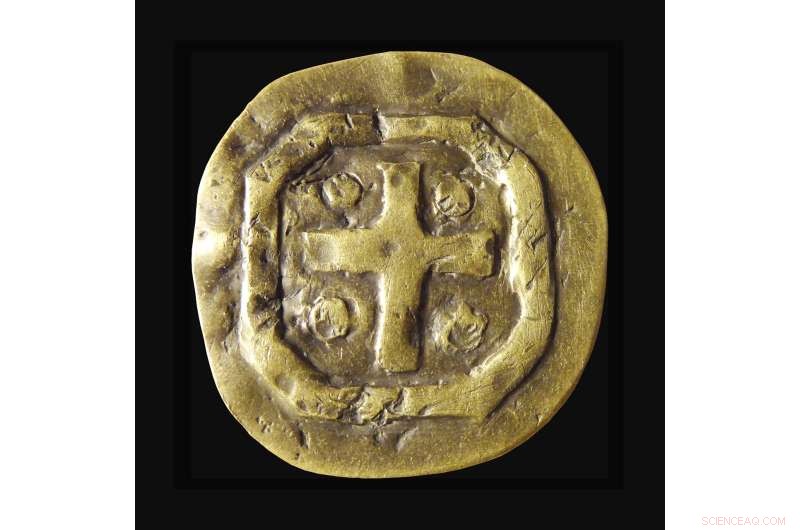
The 10th century golden Curmsun disc with the name of Danish King Harald “Bluetooth“ Gormsson (Curmsun in Latin) on it, coming from a tomb at the Roman Catholic church in Wiejkowo, Poland, photographed in Malmo, Sweden, in 2015. The Bluetooth wireless link technology is named after the king. More than 1,000 years after his death in what is now Poland, a Danish king whose nickname is known to the world through the Bluetooth technology is at the center of an archeological dispute. Credit:Sven Rosborn via AP
A family member who knew Latin understood the value of the chronicles—which dated as far back as the 10th century—and translated some of them into Polish. They mention Harald, another fact linking the Wiejkowo church to him.
The nearby Baltic Sea island and town of Wolin cultivates the region's Viking history:it has a runic stone in honor of Harald Bluetooth and holds annual festivals of Slavs and Vikings.
Kryda says the Curmsun disk is "phenomenal" with its meaningful inscription and insists that it would be worth it to examine Wiejkowo as Harald's burial place, but there are no current plans for any excavations. + Udforsk yderligere
Archaeologists find silver treasure on German Baltic island
© 2022 The Associated Press. Alle rettigheder forbeholdes. Dette materiale må ikke offentliggøres, udsendes, omskrives eller videredistribueres uden tilladelse.
 Varme artikler
Varme artikler
-
 Tidlige storvildtjægere i Amerika var kvinder, foreslår forskereIllustration af kvindelig jæger, der skildrer jægere, der kan have optrådt i Andesbjergene 9, 000 år siden. Kredit:Matthew Verdolivo, UC Davis IET Academic Technology Services I århundreder, histo
Tidlige storvildtjægere i Amerika var kvinder, foreslår forskereIllustration af kvindelig jæger, der skildrer jægere, der kan have optrådt i Andesbjergene 9, 000 år siden. Kredit:Matthew Verdolivo, UC Davis IET Academic Technology Services I århundreder, histo -
 Sådan løses ligningssystemer ved GrafingSystemer af ligninger kan hjælpe med at løse virkelige spørgsmål på alle slags områder, fra kemi til erhverv til sport. At løse dem er ikke kun vigtigt for dine matematikkarakterer; det kan spare dig
Sådan løses ligningssystemer ved GrafingSystemer af ligninger kan hjælpe med at løse virkelige spørgsmål på alle slags områder, fra kemi til erhverv til sport. At løse dem er ikke kun vigtigt for dine matematikkarakterer; det kan spare dig -
 Sådan bruges et koordinatplan i det virkelige liv <p> <p> At forstå et begreb som koordinatplanet …Koordinatsystemer er forskellige måder at beskrive på et rum. Det, du mest sandsynligt kender, er det kartesiske koordinatsystem, hvor en retning kaldes x , en vinkelret retning kaldes y og en ande
Sådan bruges et koordinatplan i det virkelige liv <p> <p> At forstå et begreb som koordinatplanet …Koordinatsystemer er forskellige måder at beskrive på et rum. Det, du mest sandsynligt kender, er det kartesiske koordinatsystem, hvor en retning kaldes x , en vinkelret retning kaldes y og en ande -
 Eksperter opfordrer til at halvere antallet af dødsulykker inden 2030Kredit:Emmy Jonsson og Pixabay Over 1,3 millioner mennesker dør i trafikulykker hvert år. Følgelig, trafikulykker er den hyppigste dødsårsag i visse aldersgrupper. Verdens eksperter samles nu i St
Eksperter opfordrer til at halvere antallet af dødsulykker inden 2030Kredit:Emmy Jonsson og Pixabay Over 1,3 millioner mennesker dør i trafikulykker hvert år. Følgelig, trafikulykker er den hyppigste dødsårsag i visse aldersgrupper. Verdens eksperter samles nu i St
- Air Canada vil midlertidigt afskedige halvdelen af sin arbejdsstyrke
- Jordens naturtyper
- Fra kontorvinduer til Mars:Forskere debuterer med superisolerende gel
- Internationale forskere bekræfter museets krympede hoved som menneskelige rester
- Forskere opretter nye bogstaver for at forbedre DNA -funktioner
- Nanowiggles:Forskere opdager grafen nanomaterialer med justerbar funktionalitet i elektronik


